1. Cartesian product and different types of relations
- Books Name
- ABCD CLASSES Mathmatics Book
- Publication
- ABCD CLASSES
- Course
- CBSE Class 12
- Subject
- Mathmatics
Chapter-1
Relations and Functions
Cartesian Product , Relations and Types of Relations
Cartesian Product
Suppose there are two non-empty sets A and B.
Then the Cartesian product of A and B is the set of all ordered pairs of elements from A and B.
i.e., A × B = {(a , b) : a ∊ A, b ∊ B}
Example: Let A = {a1,a2,a3,a4} and B = {b1,b2}
Then, The Cartesian product of A and B will be;
A × B = {(a1,b1), (a2,b1),( a3,b1),( a4,b1).( a1,b2),( a2,b2),( a3,b2),( a4,b2 )}
Example: Let us say, A = {1,2} and B = { a,b,c}
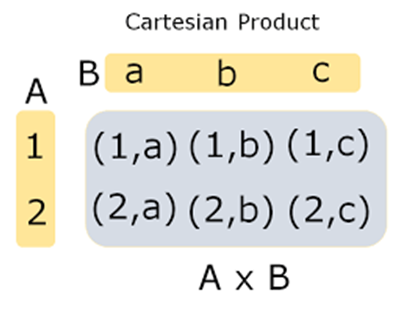
Therefore, A × B = {(1,a),(1,b),(1,c),(2,a),(2,b),(2,c)}.
This set has 8 ordered pairs. We can also represent it as in a tabular form.
Note: Two ordered pair X and Y are equal, if and only if the corresponding first elements and second elements are equal.
Example: Suppose, A = {cow, horse} B = {egg, juice}
then, A×B = {(cow, egg), (horse, juice), (cow, juice), (horse, egg)}
If either of the two sets is a null set, i.e., either A = Φ or B = Φ, then, A × B = Φ i.e., A × B will also be a null set
Number of Ordered Pairs
For two non-empty sets, A and B. If the number of elements of A is p
i.e., n(A) = p & that of B is q
i.e., n(B) = q,
then the number of ordered pairs in Cartesian product will be n(A × B) = n(A) × n(B) = pq.
Properties
- The Cartesian Product is non-commutative: A × B ≠ B × A.
- The cardinality of the Cartesian Product is defined as the number of elements in A × B and is equal to the product of cardinality of both sets:
|A × B| = |A| * |B|
- A × B = ∅, if either A = ∅ or B = ∅
- If (x,y) = (a,b) ,then x=a , y=b
- A×B=B×A, if only A=B
- The Cartesian product is associative:
(A×B)×C=A×(B×C). It means the Cartesian product of the three-set is the same, i.e., it doesn’t depend upon which bracket is multiplied first as the final result will be the same.
- Distributive property over a set intersection:
A×(B∩C)=(A×B)∩(A×C)
- Distributive property over set union:
A×(B∪C)=(A×B)∪(A×C)
- If A⊆B, then A×C⊆B×C for any set C.
- AxBxC = {(a,b,c) : aÎA, bÎ B ,cÎ C}
Here (a,b,c) is called ordered triplet.
Relation
Relation is association between two well-defined objects.
Relations can be represented in different forms such as arrow representation, algebraic form, set-builder form, graphically, roster form, and tabular form.
Definition
Let A and B be two non empty sets.
Then R : A ® B is said to be a relation if R Í AxB .
The element of A (first element) of AxB in the relation is called Domain or Pre-image of relation R.
The element of B (second element) of AxB in the relation is called Range or image of relation R.
The whole B set of AxB in the relation is called Codomain of relation R.
Range Í Codomain
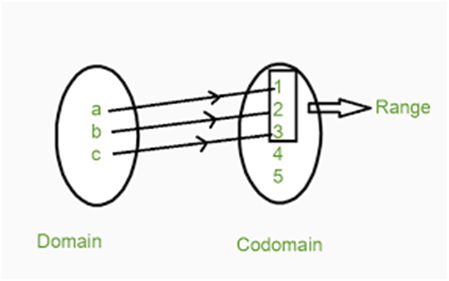
Example : Define a relation R from A to A = {1, 2, 3, 4, 5, 6} as R = {(x, y) : y = x + 1}. Determine the domain, codomain and range of R.
Answer: We can see that A = {1, 2, 3, 4, 5, 6} is the domain and codomain of R.
To determine the range, we determine the values of y for each value of x, that is, when x = 1, 2, 3, 4, 5, 6
-
- x = 1, y = 1 + 1 = 2;
- x = 2, y = 2 + 1 = 3;
- x = 3, y = 3 + 1 = 4;
- x = 4, y = 4 + 1 = 5;
- x = 5, y = 5 + 1 = 6;
- x = 6, y = 6 + 1 = 7.
Since 7 does not belong to A and the relation R is defined on A, hence, x = 6 has no image in A.
Therefore range of R = {2, 3, 4, 5, 6}
Answer: Domain = Codomain = {1, 2, 3, 4, 5, 6}, Range = {2, 3, 4, 5, 6}
Example :
Let A = {1, 2, 3, … , 14}. Define a relation R from A to A by R = {(x, y): 3x – y = 0, where x, y ∈ A}. Write down its domain, codomain and range.
ANSWER:
The relation R from A to A is given as
R = {(x, y): 3x – y = 0, where x, y ∈ A}
i.e., R = {(x, y): 3x = y, where x, y ∈ A}
∴R = {(1, 3), (2, 6), (3, 9), (4, 12)}
The domain of R is the set of all first elements of the ordered pairs in the relation.
∴Domain of R = {1, 2, 3, 4}
The whole set A is the codomainof the relation R.
∴Codomain of R = A = {1, 2, 3, …, 14}
The range of R is the set of all second elements of the ordered pairs in the relation.
∴Range of R = {3, 6, 9, 12}
Example:
The given figure shows a relationship between the sets P and Q. write this relation
(i) in set-builder form (ii) in roster form.
What is its domain and range?
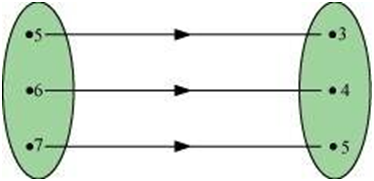
ANSWER:
According to the given figure, P = {5, 6, 7}, Q = {3, 4, 5}
(i) R = {(x, y): y = x – 2; x ∈ P} or R = {(x, y): y = x – 2 for x = 5, 6, 7}
(ii) R = {(5, 3), (6, 4), (7, 5)}
Domain of R = {5, 6, 7}
Range of R = {3, 4, 5}
Example:
Let R be the relation on Z defined by R = {(a, b): a, b ∈ Z, a – b is an integer}. Find the domain and range of R.
ANSWER:
R = {(a, b): a, b ∈ Z, a – b is an integer}
It is known that the difference between any two integers is always an integer.
∴Domain of R = Z
Range of R = Z
2. Reflexive, symmetric, transitive and equivalence and equivalence classes
- Books Name
- ABCD CLASSES Mathmatics Book
- Publication
- ABCD CLASSES
- Course
- CBSE Class 12
- Subject
- Mathmatics
Types of Relations
Given below is a list of different types of relations:
- Empty Relation
- Universal Relation
- Identity Relation
- Inverse Relation
- Reflexive Relation
- Symmetric Relation
- Transitive Relation
- Equivalence Relation
1) Empty Relation - A relation is an empty relation if it has no elements, that is, no element of set A is mapped or linked to any element of A. It is denoted by R = ∅.
For example, if set A = {1, 2, 3} then, one of the void relations can be R = {x, y} where, |x – y| = 8. For empty relation,
R = φ ⊂ A × A
2) Universal Relation - A relation R in a set A is a universal relation if each element of A is related to every element of A, i.e., R = A × A. It is called the full relation.
Consider set A = {a, b, c}. Now one of the universal relations will be R = {x, y} where, |x – y| ≥ 0. For universal relation,
R = A × A
3) Identity Relation - A relation R on A is said to be an identity relation if each element of A is related to itself, that is, R = {(a, a) : for all a ∈ A}
For example, in a set A = {a, b, c}, the identity relation will be I = {a, a}, {b, b}, {c, c}. For identity relation,
I = {(a, a), a ∈ A}
4) Inverse Relation - Define R to be a relation from set P to set Q i.e., R ∈ P × Q. The relation R-1 is said to be an Inverse relation if R-1 from set Q to P is denoted by R-1 = {(q, p): (p, q) ∈ R}.
For example if set A = {(a, b), (c, d)}, then inverse relation will be R-1 = {(b, a), (d, c)}. So, for an inverse relation,
R-1 = {(b, a): (a, b) ∈ R}
5) Reflexive Relation - A binary relation R defined on a set A is said to be reflexive if, for every element a ∈ A, we have aRa, that is, (a, a) ∈ R.
For example, consider a set A = {1, 2,}. Now an example of reflexive relation will be R = {(1, 1), (2, 2), (1, 2), (2, 1)}. The reflexive relation is given by-
(a, a) ∈ R
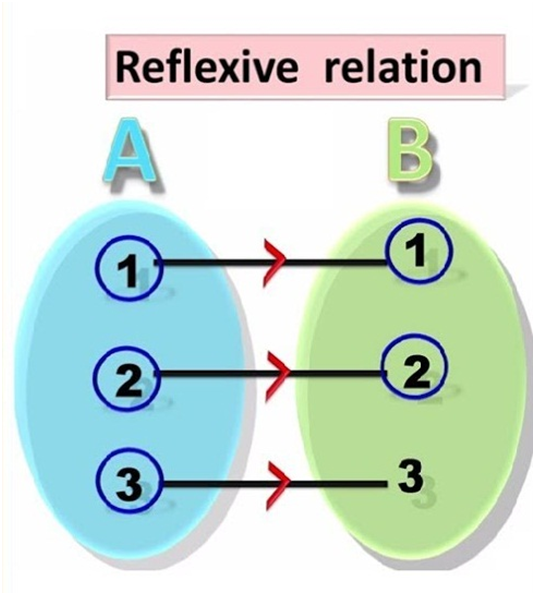
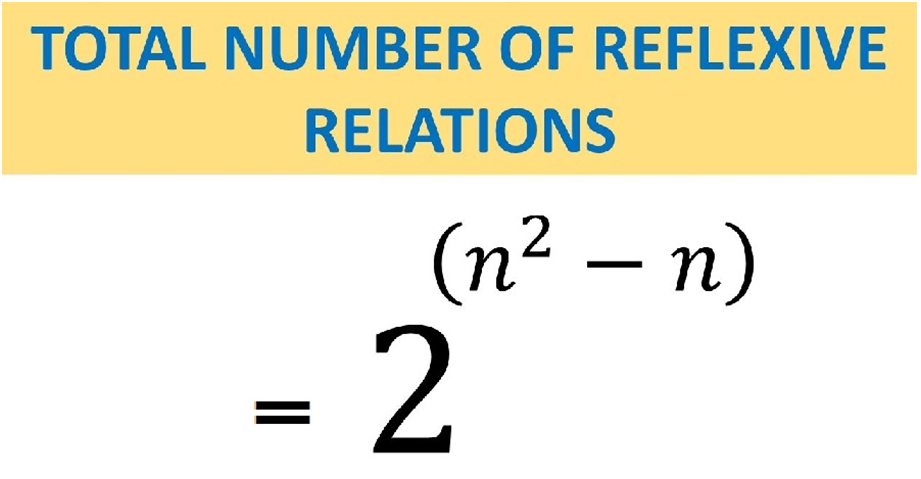
6) Symmetric Relation - A binary relation R defined on a set A is said to be symmetric if and only if, for elements a, b ∈ A, we have aRb, that is, (a, b) ∈ R, then we must have bRa, that is, (b, a) ∈ R.
An example of symmetric relation will be R = {(1, 2), (2, 1)} for a set A = {1, 2}. So, for a symmetric relation,
aRb ⇒ bRa, ∀ a, b ∈ A
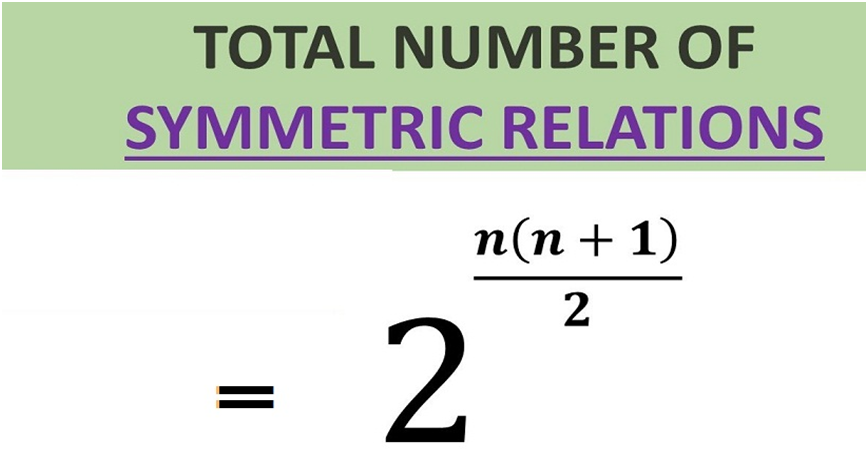
Example: For the set P={a,b}, the relation R={(a,b),(b,a)} is called symmetric relation, where a,b∈P.
7) Transitive Relation - A relation R is transitive if and only if (a, b) ∈ R and (b, c) ∈ R ⇒ (a, c) ∈ R for a, b, c ∈ A
Example: For the set A ={a,b,c}, the relation R={(a,b),(b,c),(a,c)} is called transitive relation, where a,b,c∈ A.
8) Equivalence Relation - A relation R defined on a set A is said to be an equivalence relation if and only if it is reflexive, symmetric and transitive.
Conditions:
1. If the relation (R) is reflexive, then all the elements of set A are mapped with itself, such that for every x∈ A , then (x,x)∈R.
2. The relation (R) is symmetric on set A, if (x,y)∈R, then (y,x)∈R, such that a,b∈ A.
3. The relation R on set A, if (x,y)∈R and (y,z)∈R, then (x,z)∈R, for all a,b,c∈ A is called transitive relation.
Example: Let A = {1, 2, 3, 4} and R = {(1, 1), (1, 3), (2, 2), (2, 4), (3, 1), (3, 3), (4, 2), (4, 4)}.
Show that R is an Equivalence Relation.
Solution:
Reflexive: Relation R is reflexive as (1, 1), (2, 2), (3, 3) and (4, 4) ∈ R.
Symmetric: Relation R is symmetric because whenever (a, b) ∈ R, (b, a) also belongs to R.
Example: (2, 4) ∈ R ⟹ (4, 2) ∈ R.
Transitive: Relation R is transitive because whenever (a, b) and (b, c) belongs to R, (a, c) also belongs to R.
Example: (3, 1) ∈ R and (1, 3) ∈ R ⟹ (3, 3) ∈ R.
So, as R is reflexive, symmetric and transitive, hence, R is an Equivalence Relation.
Question 1:
Let us assume that F is a relation on the set R real numbers defined by x F y if and only if x-y is an integer. Prove that F is an equivalence relation on R.
Solution:
Reflexive: Let x belongs to R,then x – x = 0 which is an integer.
Therefore x F x.
So , F is reflexive.
Symmetric: Let x and y belongs to R and x F y.
- x – y is an integer.
- Thus, y – x = – ( x – y), y – x is also an integer.
- Therefore yFx.
So , F is Symmetric.
Transitive: Let x and y belongs to R, xFy and yFz.
- x-y and y-z are integers.
- ( x – y ) + ( y – z ) = x – z is also an integer.
- So that xFz.
So , F is Transitive.
Thus, R is an equivalence relation on R.
Question 2:
Show that the relation R is an equivalence relation in the set A = { 1, 2, 3, 4, 5 } given by the relation R = { (a, b):|a-b| is even }.
Solution:
R = { (a, b):|a-b| is even }. Where a, b belongs to A
Reflexive Property :
Let a is belongs to A.
|a – a| = | 0 |=0
- 0 is always even.
- Thus, |a-a| is even
- Therefore, (a, a) belongs to R
Hence R is Reflexive
Symmetric Property :
Let a, b belongs to A
|a – b| = |b – a|
Let a R b
We know that |a – b| = |-(b – a)|= |b – a|
- |a – b| is even,
- |b – a| is also even.
Therefore, if (a, b) ∈ R, then (b, a) belongs to R
Hence R is symmetric.
Transitive Property :
Let a, b, c belongs to A
Let a R b and b R c
- |b-c| is even and (b-c) is even
Since , If |a-b| is even, then (a-b) is even.
Sum of even number is also even
- a-b+ b-c is even
- a – c is also even
Then, a R c
So,
|a – b| and |b – c| is even , then |a-c| is even.
Therefore, if (a, b) ∈ R and (b, c) ∈ R, then (a, c) also belongs to R
Hence R is transitive.
Therefore R is an equivalence relation.
Equivalence Class
Let R be an equivalence relation on set A. For each a∈A, we denote the equivalence class of a as [a] defined as:
[a]={x ∈A ∣ x R a}
Example:
Define a relation ∼ on Z by
a∼b⇔a mod 4=b mod 4
Find the equivalence classes of ∼
Answer
Two integers will be related by ∼ if they have the same remainder after dividing
by 4. The possible remainders are 0, 1, 2, 3
[0]={...,−12,−8,−4,0,4,8,12,...}
[1]={...,−11,−7,−3,1,5,9,13,...}
[2]={...,−10,−6,−2,2,6,10,14,...}
[3]={...,−9,−5,−1,3,7,11,15,...}
Example:
Let S=P({1,2,3})={∅,{1},{2},{3},{1,2},{1,3},{2,3},{1,2,3}}.
For convenience, label
S0=∅,S1={1},S2={2},S3={3},S4={1,2},S5={1,3},S6={2,3},S7={1,2,3}.
Define this equivalence relation ∼ on S by
Si∼Sj⇔|Si|=|Sj|
Find the equivalence classes of ∼.
Answer
Two sets will be related by ∼ if they have the same number of elements.
[S0]={S0}
[S2]={S1,S2,S3}
[S4]={S4,S5,S6}
[S7]={S7}
Example:
Consider set S={a,b,c,d} with this partition: {{a,b},{c},{d}}.
Find the ordered pairs for the relation R, induced by the partition.
Proof
R={(a,a),(a,b),(b,a),(b,b),(c,c),(d,d)}
Question :
Let R be a relation from N to N defined by R = {(a, b): a, b ∈ N and a = b2}. Are the following true?
(i) (a, a) ∈ R, for all a ∈ N
(ii) (a, b) ∈ R, implies (b, a) ∈ R
(iii) (a, b) ∈ R, (b, c) ∈ R implies (a, c) ∈ R.
Justify your answer in each case.
ANSWER:
R = {(a, b): a, b ∈ N and a = b2}
(i) It can be seen that 2 ∈ N;however, 2 ≠ 22 = 4.
Therefore, the statement “(a, a) ∈ R, for all a ∈ N” is not true.
(ii) It can be seen that (9, 3) ∈ N because 9, 3 ∈ N and 9 = 32.
Now, 3 ≠ 92 = 81; therefore, (3, 9) ∉ N
Therefore, the statement “(a, b) ∈ R, implies (b, a) ∈ R” is not true.
(iii) It can be seen that (16, 4) ∈ R, (4, 2) ∈ R because 16, 4, 2 ∈ N and 16 = 42 and 4 = 22.
Now, 16 ≠ 22 = 4; therefore, (16, 2) ∉ N
Therefore, the statement “(a, b) ∈ R, (b, c) ∈ R implies (a, c) ∈ R” is not true.
Example 5: Check whether the relation R defined in the set {1, 2, 3, 4, 5, 6} as R = {(a, b): b = a + 1} is reflexive, symmetric or transitive.
Solution:
Given R = {(a, b): b = a + 1}
Now for this relation we have to check whether it is reflexive, transitive and symmetric Reflexivity:
Let a be an arbitrary element of R.
Then, a = a + 1 cannot be true for all a ∈ A.
⇒ (a, a) ∉ R
So, R is not reflexive on A.
Symmetry:
Let (a, b) ∈ R
⇒ b = a + 1
⇒ −a = −b + 1
⇒ a = b − 1
Thus, (b, a) ∉ R
So, R is not symmetric on A.
Transitivity:
Let (1, 2) and (2, 3) ∈ R
⇒ 2 = 1 + 1 and 3
2 + 1 is true.
But 3 ≠ 1+1
⇒ (1, 3) ∉ R
So, R is not transitive on A.
Example 6: Check whether the relation R on R defined as R = {(a, b): a ≤ b3} is reflexive, symmetric or transitive.
Solution:
Given R = {(a, b): a ≤ b3}
It is observed that (1/2, 1/2) in R as 1/2 > (1/2)3 = 1/8
∴ R is not reflexive.
Now,
(1, 2) ∈ R (as 1 < 23 = 8)
But,
(2, 1) ∉ R (as 2 > 13 = 1)
∴ R is not symmetric.
We have (3, 3/2), (3/2, 6/5) in “R as” 3 < (3/2)3 and 3/2 < (6/5)3
But (3, 6/5) ∉ R as 3 > (6/5)3
∴ R is not transitive.
Hence, R is neither reflexive, nor symmetric, nor transitive.
Example 7: Prove that every identity relation on a set is reflexive, but the converse is not necessarily true.
Solution:
Let A be a set.
Then, Identity relation IA=IA is reflexive, since (a, a) ∈ A ∀a
The converse of it need not be necessarily true.
Consider the set A = {1, 2, 3}
Here,
Relation R = {(1, 1), (2, 2) , (3, 3), (2, 1), (1, 3)} is reflexive on A.
However, R is not an identity relation.
Example 8: If A = {1, 2, 3, 4} define relations on A which have properties of being
(i) Reflexive, transitive but not symmetric
(ii) Symmetric but neither reflexive nor transitive.
(iii) Reflexive, symmetric and transitive.
Solution:
(i) The relation on A having properties of being reflexive, transitive, but not symmetric is
R = {(1, 1), (2, 2), (3, 3), (4, 4), (2, 1)}
Relation R satisfies reflexivity and transitivity.
⇒ (1, 1), (2, 2), (3, 3) ∈ R
And (1, 1), (2, 1) ∈ R ⇒ (1, 1) ∈ R
However, (2, 1) ∈ R, but (1, 2) ∉ R
(ii) The relation on A having properties of being reflexive, transitive, but not symmetric is
R = {(1, 1), (2, 2), (3, 3), (4, 4), (2, 1)}
Relation R satisfies reflexivity and transitivity.
⇒ (1, 1), (2, 2), (3, 3) ∈ R
And (1, 1), (2, 1) ∈ R ⇒ (1, 1) ∈ R
However, (2, 1) ∈ R, but (1, 2) ∉ R
(iii) The relation on A having properties of being symmetric, reflexive and transitive is
R = {(1, 1), (2, 2), (3, 3), (4, 4), (1, 2), (2, 1)}
The relation R is an equivalence relation on A.
Example 9:. Show that the relation R defined by R = {(a, b): a – b is divisible by 3; a, b ∈ Z} is an equivalence relation.
Solution:
Given R = {(a, b): a – b is divisible by 3; a, b ∈ Z} is a relation
To prove equivalence relation it is necessary that the given relation should be reflexive, symmetric and transitive.
Let us check these properties on R.
Reflexivity:
Let a be an arbitrary element of R.
Then, a – a = 0 = 0 × 3
⇒ a − a is divisible by 3
⇒ (a, a) ∈ R for all a ∈ Z
So, R is reflexive on Z.
Symmetry:
Let (a, b) ∈ R
⇒ a − b is divisible by 3
⇒ a − b = 3p for some p ∈ Z
⇒ b − a = 3 (−p)
Here, −p ∈ Z
⇒ b − a is divisible by 3
⇒ (b, a) ∈ R for all a, b ∈ Z
So, R is symmetric on Z.
Transitivity:
Let (a, b) and (b, c) ∈ R
⇒ a − b and b − c are divisible by 3
⇒ a – b = 3p for some p ∈ Z
And b − c = 3q for some q ∈ Z
Adding the above two equations, we get
a − b + b – c = 3p + 3q
⇒ a − c = 3 (p + q)
Here, p + q ∈ Z
⇒ a − c is divisible by 3
⇒ (a, c) ∈ R for all a, c ∈ Z
So, R is transitive on Z.
Therefore R is reflexive, symmetric and transitive.
Hence, R is an equivalence relation on Z.
Example 10: Show that the relation R on the set Z of integers, given by
R = {(a, b): 2 divides a – b}, is an equivalence relation.
Solution:
Given R = {(a, b): 2 divides a – b} is a relation defined on Z.
To prove equivalence relation it is necessary that the given relation should be reflexive, symmetric and transitive.
Let us check these properties on R.
Reflexivity:
Let a be an arbitrary element of the set Z.
Then, a ∈ R
⇒ a − a = 0 = 0 × 2
⇒ 2 divides a − a
⇒ (a, a) ∈ R for all a ∈ Z
So, R is reflexive on Z.
Symmetry:
Let (a, b) ∈ R
⇒ 2 divides a − b
⇒ (a-b)/2 = p for some p ∈ Z
⇒ (b-a)/2 = – p
Here, −p ∈ Z
⇒ 2 divides b − a
⇒ (b, a) ∈ R for all a, b ∈ Z
So, R is symmetric on Z
Transitivity:
Let (a, b) and (b, c) ∈ R
⇒ 2 divides a−b and 2 divides b−c
⇒ (a-b)/2 = p and (b-c)/2 = q for some p, q ∈ Z
Adding the above two equations, we get
(a – b)/2 + (b – c)/2 = p + q
⇒ (a – c)/2 = p +q
Here, p+ q ∈ Z
⇒ 2 divides a − c
⇒ (a, c) ∈ R for all a, c ∈ Z
So, R is transitive on Z.
Therefore R is reflexive, symmetric and transitive.
Hence, R is an equivalence relation on Z.
Example 11:. Prove that the relation R on Z defined by (a, b) ∈ R ⇔ a − b is divisible by 5 is an equivalence relation on Z.
Solution:
Given relation R on Z defined by (a, b) ∈ R ⇔ a − b is divisible by 5
To prove equivalence relation it is necessary that the given relation should be reflexive, symmetric and transitive.
Let us check these properties on R.
Reflexivity:
Let a be an arbitrary element of R. Then,
⇒ a − a = 0 = 0 × 5
⇒ a − a is divisible by 5
⇒ (a, a) ∈ R for all a ∈ Z
So, R is reflexive on Z.
Symmetry:
Let (a, b) ∈ R
⇒ a − b is divisible by 5
⇒ a − b = 5p for some p ∈ Z
⇒ b − a = 5 (−p)
Here, −p ∈ Z [Since p ∈ Z]
⇒ b − a is divisible by 5
⇒ (b, a) ∈ R for all a, b ∈ Z
So, R is symmetric on Z.
Transitivity:
Let (a, b) and (b, c) ∈ R
⇒ a − b is divisible by 5
⇒ a − b = 5p for some Z
Also, b − c is divisible by 5
⇒ b − c = 5q for some Z
Adding the above two equations, we get
a −b + b − c = 5p + 5q
⇒ a − c = 5 ( p + q )
⇒ a − c is divisible by 5
Here, p + q ∈ Z
⇒ (a, c) ∈ R for all a, c ∈ Z
So, R is transitive on Z.
Therefore R is reflexive, symmetric and transitive.
Hence, R is an equivalence relation on Z.
Example 12:. Let n be a fixed positive integer. Define a relation R on Z as follows:
(a, b) ∈ R ⇔ a − b is divisible by n.
Show that R is an equivalence relation on Z.
Solution:
Given (a, b) ∈ R ⇔ a − b is divisible by n is a relation R defined on Z.
To prove equivalence relation it is necessary that the given relation should be reflexive, symmetric and transitive.
Let us check these properties on R.
Reflexivity:
Let a ∈ N
Here, a − a = 0 = 0 × n
⇒ a − a is divisible by n
⇒ (a, a) ∈ R
⇒ (a, a) ∈ R for all a ∈ Z
So, R is reflexive on Z.
Symmetry:
Let (a, b) ∈ R
Here, a − b is divisible by n
⇒ a − b = n p for some p ∈ Z
⇒ b − a = n (−p)
⇒ b − a is divisible by n [ p ∈ Z⇒ − p ∈ Z]
⇒ (b, a) ∈ R
So, R is symmetric on Z.
Transitivity:
Let (a, b) and (b, c) ∈ R
Here, a − b is divisible by n and b − c is divisible by n.
⇒ a − b= n p for some p ∈ Z
And b−c = n q for some q ∈ Z
a – b + b − c = n p + n q
⇒ a − c = n (p + q)
⇒ (a, c) ∈ R for all a, c ∈ Z
So, R is transitive on Z.
Therefore R is reflexive, symmetric and transitive.
Hence, R is an equivalence relation on Z
3. Different types of functions their domain and range
- Books Name
- ABCD CLASSES Mathmatics Book
- Publication
- ABCD CLASSES
- Course
- CBSE Class 12
- Subject
- Mathmatics
FUNCTIONS
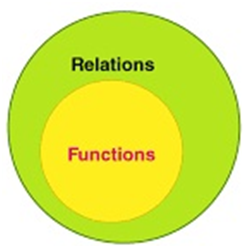
It is a special type of relation.
Defn: A relation R:AàB is said to be a function if every element of a set A has only one image in set B.
Or
A relation R:AàB is said to be a function if Domain(R)=A and One many relation is not present.
Or
A special relationship where each input has a single output. It is often written as "f(x)" where x is the input value.
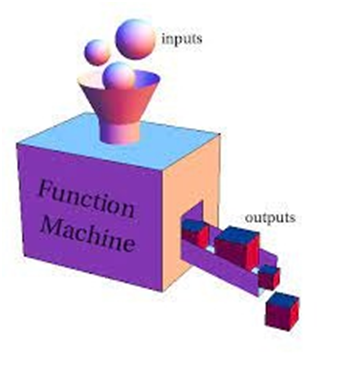
Example:
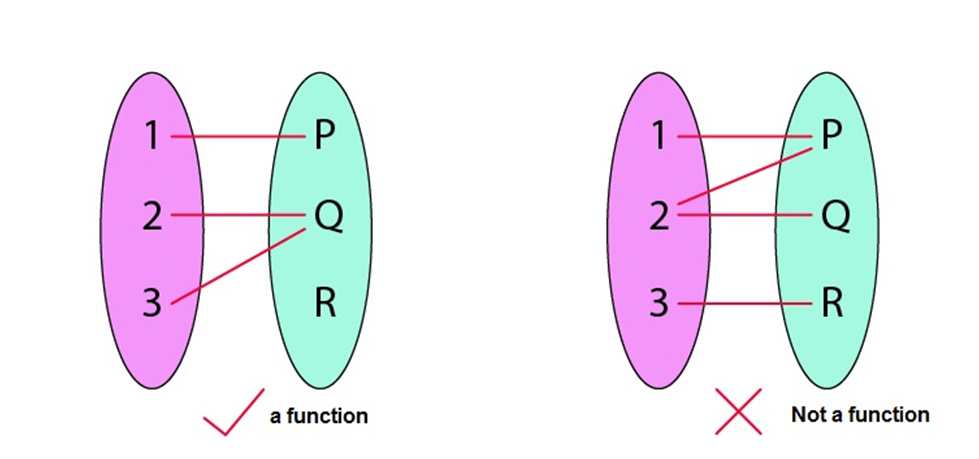
Different types of functions their domain and range
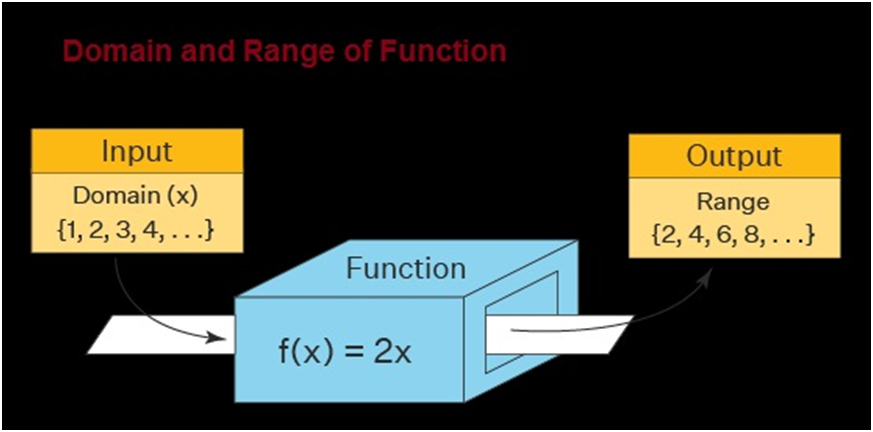
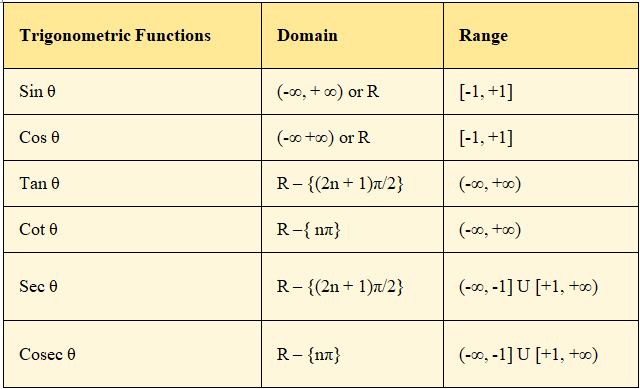
4. One-one(injective) functions, onto (surjective) functions, bijective functions.
- Books Name
- ABCD CLASSES Mathmatics Book
- Publication
- ABCD CLASSES
- Course
- CBSE Class 12
- Subject
- Mathmatics
Types of Functions
One to one Function: A function f : X → Y is defined to be one-one (or injective), if the images of distinct elements of X under f are distinct,
i.e., for every x1 , x2 ∈ X, f(x1 ) = f(x2 ) implies x1 = x2 . Otherwise, f is called many-one.


Examples
Examples of one-one / injective Function
- The identity function X → X is always one-one.
- If function f: R→ R, then f(x) = 2x is one-one.
- If function f: R→ R, then f(x) = 2x+1 is one-one.
- If function f: R→ R, then f(x) = x2 is not an injective function, because here
if x = -1, then f(-1) = 1 = f(1). Hence, the element of co-domain is not discrete here.
- If function f: R→ R, then f(x) = x/2 is one-one.
- If function f: R→ R, then f(x) = x3 is one-one.
- If function f: R→ R, then f(x) = 4x+5 is one-one.
Properties of One-One Function
- If f and g are both one to one, then f ∘ g follows one-one.
- If g ∘ f is one to one, then function f is one to one, but function g may not be.
- f: X → Y is one-one, if and only if, given any functions g, h : P → X whenever f ∘ g = f ∘ h, then g = h..
- If f: X → Y is one-one and P is a subset of X, then f-1 (f(A)) = P. Thus, P can be retrieved from its image f(P).
- If f: X → Y is one-one and P and Q are both subsets of X, then f(P ∩ Q) = f(P) ∩ f(Q).
- If both X and Y are limited with the same number of elements, then f: X → Y is one-one, if and only if f is surjective or onto function.
Example :
Show that f: R→ R defined as f(a) = 3x3 – 4 is one to one function?
Solution:
Let f ( x1 ) = f ( x2 ) for all a1 , a2 ∈ R
- 3x13 – 4 = 3x23 – 4
- x13 = x23
- x13 – x23 = 0
- (x1 – x2) (x1 + x1x2 + x22) = 0
- x1 = x2 and (x12 + x1x2 + x22) = 0
- (x12 + x1x2 + x22) = 0 is not considered because there are no real values of x1 and x2.
Therefore, the given function f is one-one.
- Onto Function: A function f: X → Y is said to be onto (or surjective), if every element of Y is the image of some element of X under f,(Codomain=Range)
i.e., for every y ∈ Y, there exists an element x in X such that f(x) = y.

 Chintu
Chintu
